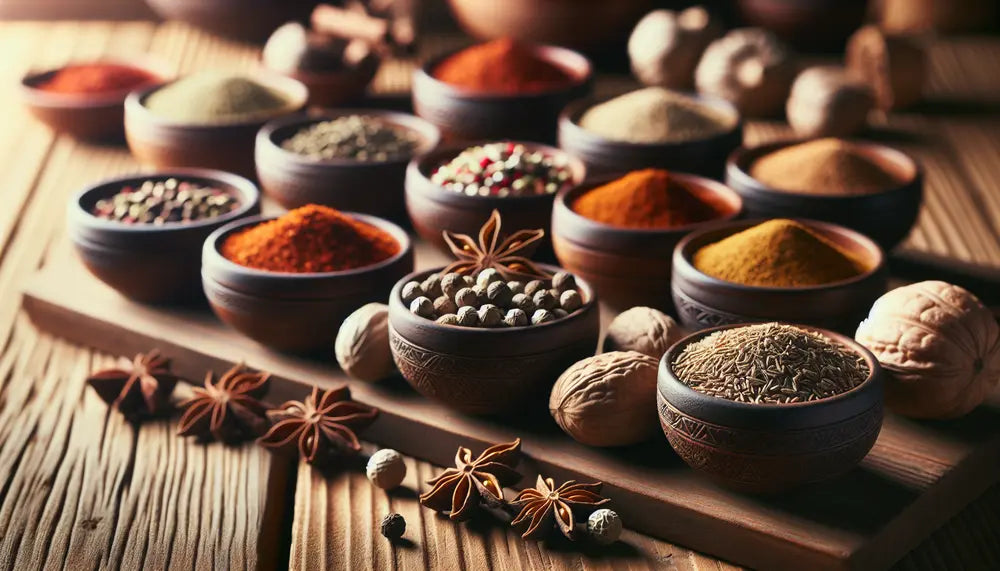
A culinary journey to Spain: spices Spanish
The importance of spices in Spanish cuisine
Spanish cuisine is world famous for its diversity and intensity of the flavors, whereby Spices play a central role. In Spain, the use of spices is not just about making food more tasty. Spices are an essential part of cultural identity and history. From the markets of Andalusia to the taverns of Catalonia, Spices Form the culinary heritage of Spain.
Traditionally used spices such as saffron, peppers and laurel leaves are more than just ingredients; They are an expression of Spain's regional diversity. These spices give the classic dishes such as paella, tapas and chorizo their unmistakable tastes. They also play an important role in religious and festive occasions that shape the Spanish way of life.
Not to be forgotten is the health component that many Spanish spices bring. Studies suggest that regular use of certain spices can contribute to the prevention of different diseases. This reflects the deep link between Spanish cuisine and a healthy lifestyle.
In summary, spices in Spanish cuisine are not only crucial for the taste, but also for the promotion of a rich cultural and healthy lifestyle. They are indispensable components that make every bit not only a taste experience, but also a culinary journey of discovery.
Typical Spanish spices and their application
There are some in Spanish cuisine Spices Particularly characteristic and shape the distinctive taste of the dishes. Here is an overview of typical Spanish spices and their typical application:
- Spanish saffron - Highly estimated for its unique aroma and its toughness, Safran is traditionally used in Paella, fish soups and rice dishes.
- rosemary - This aromatic herb is used in meat dishes, especially in lamb and chicken recipes, as well as in stews and sauces.
- thyme · Often used in combination with other herbs to refine gear dishes and patients.
- Laurel leaves - A classic spice for stews, soups and the preparation of fish. They are usually removed at the end of the cooking time.
These spices are estimated not only because of their taste, but also because of their ability to underline and reinforce the flavors of natural ingredients. 1
The use of the spices is as diverse as the Spanish landscape itself, and every spice contributes to its own history and tradition.
Advantages and disadvantages of famous Spanish Gwerze
| Germ | Advantages | Disadvantages |
|---|---|---|
| Saffron | Intensive aroma, promotes digestion | Very expensive, excessive consumption can be unhealthy |
| Pimentón (paprika) | Versatile, rich in vitamin C | Can cause stomach irritation if there is excessive consumption |
| Chorizo germs | Gives dishes a piquant note, good fat source | Can be too sharp for some palates, often contains a lot of salt |
Saffran: The golden spice of Spain
Saffran, often as that Golden spice of Spain Described, plays an outstanding role in Spanish gastronomy. This spice is not only popular because of its intensive color and its unique taste, but also because of its diverse possible uses in the kitchen.
The extraction of saffron is known to be labor-intensive, since the saffron threads must be plucked by hand from the flowers of the saffron crocuses. This activity, which takes place primarily in the La Mancha region, is typically carried out in October when the crocuses bloom.
In the culinary sector, Saffran is mainly used to do rice dishes such as the famous Paellato give a golden yellow color and a spicy aroma. But also in soups, seafood dishes and sauces, the spice is used and ensures a taste of taste that is rarely found in other kitchens.
In addition, Saffran in Spain is estimated due to its alleged health -promoting properties. He is said to have antioxidant properties and to have a positive impact on eyesight and mood.†
The importance of saffron for Spanish cuisine and culture cannot be assessed high enough. It not only gives many traditional dishes their characteristic color and their taste, but is also a symbol of the rich cultural history of Spain.
Paprika: a versatile spice in Spanish gastronomy
Paprika, also known as Pimentón in Spain, another central spice that flows into many facets of Spanish cuisine. From mild to sharp, the pepper offers a range of flavors that make Spanish dishes unmistakable.
In Spain, a distinction is made between three main locations of peppers: sweet (dulce), bittersweet (Agridulce) and sharp (Picante). This variety enables the spice to be flexibly used in various recipes, from meat dishes to vegetarian.
The pepper plays a special role in the production of Chorizo, a spicy Spanish paprika sausage. Here he not only gives the characteristic red color, but also the piquant aroma, which makes chorizo known worldwide. It is equally important for the preparation of stews and ragouts, where he contributes a profound spice.
The regional differences in the use of peppers can be clearly seen in Spain. While there is a preference for the sharp variant in some regions, others prefer the milder forms. This regional taste shapes the identity of Spanish kitchens and shows how a single spice can take on a wide variety of forms.
In addition to its culinary importance, Paprika is also appreciated for its health benefits. It is rich in vitamin C and antioxidants†that can contribute to the protection of the body.
The flexibility and the deeply rooted tradition of the paprika in Spanish cuisine make it an indispensable part of the gastronomic landscape of Spain.
Chorizo and Pimentón: a spicy combination
Chorizo and Pime are among the most iconic aromas of Spain and together form a spicy combination that is used in many traditional dishes. This combination not only gives the dishes a deep red color, but also a deep, complex aroma.
The composition of the chorizo usually includes pork, which is seasoned with Pimentón, as well as other spices such as garlic and salt. The Pimentón variety that is used determines the sharpness of the sausage: from sweet and mild to strong and sharp.
Chorizo is produced by combining the ingredients, followed by a maturation process in which the sausage is air dried. This process reinforces the flavors and ensures the typical texture. Traditionally, chorizo is cut into thick slices and can be both cooked and fried or served as part of stews and tapas.
The use of Pimentón in the Chorizo is not only crucial for the taste, but also has conservative properties that play an important role in traditional Spanish food processing.
In Spain, this spicy combination is often enjoyed at festivals and family celebrations and is an integral part of hospitality and culinary pride. The enthusiasm for chorizo and Pimentón shows how deeply rooted and essential these ingredients are in Spanish cuisine.
Modern and traditional use of spices in Spain
In Spain, the use of spices is a bridge between tradition and modernity. While classic recipes are still being held up, contemporary cooks with these aromas experiment to create innovative dishes.
Spices such as saffron, Pimentón and laurel are traditionally used in the preparation of regional specialties. This deep rooting in the culinary history of Spain is shown in dishes such as the paella, which would be unthinkable without saffron, or the chorizo, which owes its characteristic taste to the Pimentón.
However, modern Spanish cuisine takes freedom to reinterpret these spices. Modern fusion kitchens focus on using spices in less traditional contexts, for example in avant-garde desserts or in cocktails. This innovative approach has led to traditional spices experience a renaissance and appear in new formats that fascinate both locals and tourists.
The use of spices in Spain is therefore an exciting field that preserves traditions and opens up new gastronomic horizons. This duality reflects the respect for history and an openness to innovations, which makes Spanish cuisine so unique and lively.
Whether old or new - the spices are an inexhaustible source of inspiration and help to ensure that Spanish gastronomy honors both its roots and remains future -oriented.
Buy and store spices: tips for lovers of Spanish cuisine
For lovers of Spanish cuisine, it is essential to the right ones Spices To buy and keep it optimally to maintain the authentic aroma of Spanish dishes. Here are some practical tips to get the best out of your spices.
- Buying high quality spices: Prefer spices from specialized shops or from trustworthy online providers that offer fresh products. Pay attention to the country of origin and the date of processing.
- Correct storage: Spices should be stored in airtight containers in a cool, dark place. Light, heat and moisture can weaken the aromas and shorten the durability.
- Portion: Buy spices in quantities that you can consume within one year. Freshness is crucial for the taste in spices.
In order to protect the maximum freshness and aroma of the spices, it is also advisable to buy entire spices and to grind it shortly before use. Tools such as a mortar or a spice mill are ideal for this.
With these tips you can ensure the quality of your Spanish spices and raise your culinary skills to a new level. Whether you spice up a simple dish or prepare an elaborate menu - the correct care and handling of your spices will make a noticeable difference.
Conclusion: How Spanish spices can enrich your kitchen
The introduction of Spanish spices in your kitchen can be a real enrichment that not only for Taste explosions ensures, but also a culinary bridge hits a rich cultural tradition. Spanish spices offer an incomparable variety that ranges from sweet and mild to sharp and intense notes.
They open up new culinary perspectives and offer the opportunity to cook traditional dishes authentically or to develop their own creations. By using Spanish spices, every food not only becomes a feast for the palate, but also a small festival of Spanish lifestyle.
Result: Spanish spices are more than just additives; They are a gate to a world full of flavors that can enliven and enrich their kitchen routine. Take the adventure of the Spanish spices and be inspired and enchanted by your diversity.
Whether experienced cook or enthusiastic beginner, Spanish spices are an enrichment that will expand your culinary skills and will transform your meals into an enjoyable experience.
FAQ: Discover Spanish G isch
What are typical Spanish ghugers?
Typical Spanish ghugers include saffron, pimentón (paprika), rosemary, thyme and laurel leaves. These ghugs shape the unmistakable taste of Spanish cuisine.
How do you use saffron in Spanish cuisine?
Saffran is mainly used in dishes such as Paella, where it ensures the golden color and the aromatic taste profile. A small amount is enough to give a dish a rich color and a pronounced taste.
What are the health benefits of Spanish G isches?
Many Spanish ghugers such as peppers and saffron are known for their antioxidant properties and can contribute to general health promotion.
Can you just use Spanish G islands at home?
Yes, Spanish ghugers are easy to use in everyday recipes to give each dish an authentic Spanish note. Simple dishes such as roasted chicken or vegetable stews can be refined with ghugs such as Pimentón or rosemary.
How do you keep Spanish ghwels properly?
Spanish ghugers should be stored in airtight containers in a cool, dark place to preserve their freshness and aremot notes. Avoid keeping it in the direct sun or in damp areas.



Leave a comment
This site is protected by hCaptcha and the hCaptcha Privacy Policy and Terms of Service apply.